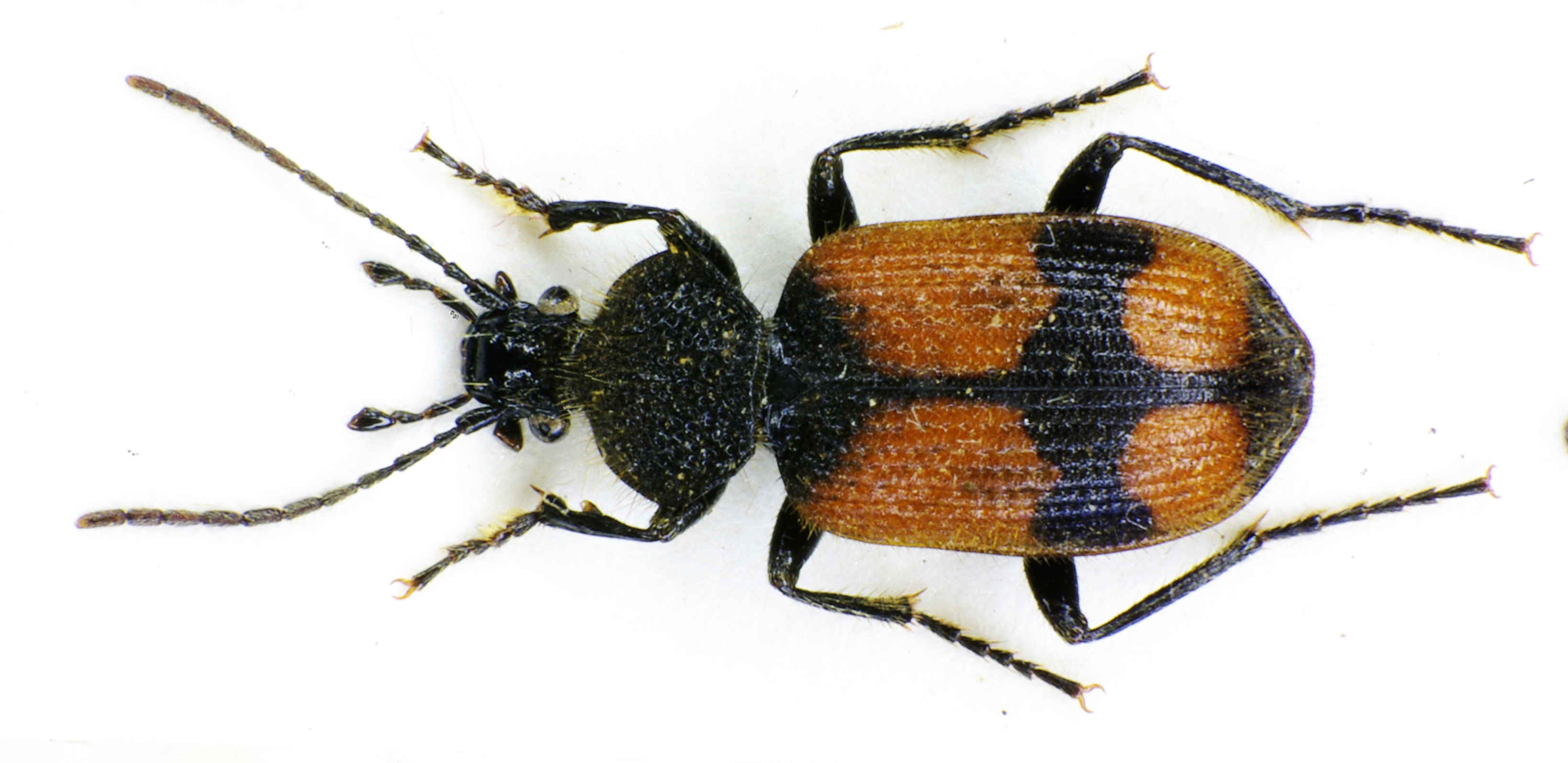|
Max Liebke
Max Liebke (12 February 1892 – 1945) was a German entomologist, who researched ground beetles. He wrote in a journal called ''Entomologischer Anzeiger'', describing beetles that he discovered. Liebke was born Max Heinrich Wilhelm Liebke in Hamburg on 12 February 1892. His parents were Ernst August Julius Liebke and Anna Margaretha Dorothea Liebke (nee Wenk). On 21 February 1914 in Hamburg, 22 year old Liebke married 21 year old Minna Caroline Marie Antonie Elisabeth Amthor. Both are described as Lutherans on their marriage record. Between 1927 and 1940, Liebke authored at least 33 scientific papers, mainly about Carabidae. Liebke was listed as missing at Posen Poznań.html" ;"title="nowiki/>Poznań">Poznań, Polandin 1944. Like's birth registration document bears an official stamp noting that he was formally declared dead on 11 October 1951, but is considered to have been dead by the end of 1945. In 1932 Liebke gifted 5,344 beetle specimens to the Zoological Museum in Hamb ... [...More Info...] [...Related Items...] OR: [Wikipedia] [Google] [Baidu] |
Hamburg
Hamburg (, ; ), officially the Free and Hanseatic City of Hamburg,. is the List of cities in Germany by population, second-largest city in Germany after Berlin and List of cities in the European Union by population within city limits, 7th-largest in the European Union with a population of over 1.9 million. The Hamburg Metropolitan Region has a population of over 5.1 million and is the List of EU metropolitan areas by GDP, eighth-largest metropolitan region by GDP in the European Union. At the southern tip of the Jutland Peninsula, Hamburg stands on the branching River Elbe at the head of a estuary to the North Sea, on the mouth of the Alster and Bille (Elbe), Bille. Hamburg is one of Germany's three city-states alongside Berlin and Bremen (state), Bremen, and is surrounded by Schleswig-Holstein to the north and Lower Saxony to the south. The Port of Hamburg is Germany's largest and Europe's List of busiest ports in Europe, third-largest, after Port of Rotterdam, Rotterda ... [...More Info...] [...Related Items...] OR: [Wikipedia] [Google] [Baidu] |
Germany
Germany, officially the Federal Republic of Germany, is a country in Central Europe. It lies between the Baltic Sea and the North Sea to the north and the Alps to the south. Its sixteen States of Germany, constituent states have a total population of over 84 million in an area of , making it the most populous member state of the European Union. It borders Denmark to the north, Poland and the Czech Republic to the east, Austria and Switzerland to the south, and France, Luxembourg, Belgium, and the Netherlands to the west. The Capital of Germany, nation's capital and List of cities in Germany by population, most populous city is Berlin and its main financial centre is Frankfurt; the largest urban area is the Ruhr. Settlement in the territory of modern Germany began in the Lower Paleolithic, with various tribes inhabiting it from the Neolithic onward, chiefly the Celts. Various Germanic peoples, Germanic tribes have inhabited the northern parts of modern Germany since classical ... [...More Info...] [...Related Items...] OR: [Wikipedia] [Google] [Baidu] |
Entomology
Entomology (from Ancient Greek ἔντομον (''éntomon''), meaning "insect", and -logy from λόγος (''lógos''), meaning "study") is the branch of zoology that focuses on insects. Those who study entomology are known as entomologists. In the past, the term ''insect'' was less specific, and historically the definition of entomology would also include the study of animals in other arthropod groups, such as arachnids, myriapods, and crustaceans. The field is also referred to as insectology in American English, while in British English insectology implies the study of the relationships between insects and humans. Over 1.3million insect species have been described by entomology. History Entomology is rooted in nearly all human cultures from prehistoric times, primarily in the context of agriculture (especially biological control and beekeeping). The natural Roman philosopher Pliny the Elder (23–79 CE) wrote a book on the kinds of insects, while the scientist Grammarians ... [...More Info...] [...Related Items...] OR: [Wikipedia] [Google] [Baidu] |
Ground Beetle
Ground beetles are a large, cosmopolitan distribution, cosmopolitan family (biology), family of beetles, the Carabidae, with more than 40,000 species worldwide, around 2,000 of which are found in North America and 2,700 in Europe. As of 2015, it is one of the 10 most species-rich animal families. They belong to the Adephaga. Members of the family are primarily Carnivore, carnivorous, but some members are Herbivore, herbivorous or Omnivore, omnivorous. Description and ecology Although their body shapes and coloring vary somewhat, most are shiny black or metallic and have ridged wing covers (elytra). The elytra are fused in some species, particularly the large Carabinae, rendering the beetles unable to fly. The species ''Mormolyce phyllodes'' is known as violin beetle due to their peculiarly shaped elytra. All carabids except the quite primitive flanged bombardier beetles (Paussinae) have a groove on their arthropod leg, fore leg tibiae bearing a comb of hairs used for cleaning the ... [...More Info...] [...Related Items...] OR: [Wikipedia] [Google] [Baidu] |
Poznań
Poznań ( ) is a city on the Warta, River Warta in west Poland, within the Greater Poland region. The city is an important cultural and business center and one of Poland's most populous regions with many regional customs such as Saint John's Fair, Poznań, Saint John's Fair (''Jarmark Świętojański''), traditional St. Martin's croissant, Saint Martin's croissants and a local dialect. Among its most important heritage sites are the Renaissance in Poland, Renaissance Old Town, Poznań Town Hall, Town Hall and Poznań Cathedral. Poznań is the fifth-largest List of cities and towns in Poland#Cities, city in Poland. As of 2023, the city's population is 540,146, while the Poznań metropolitan area (''Metropolia Poznań'') comprising Poznań County and several other communities is inhabited by over 1.029 million people. It is one of four historical capitals of medieval Poland and the ancient capital of the Greater Poland region, currently the administrative capital of the pr ... [...More Info...] [...Related Items...] OR: [Wikipedia] [Google] [Baidu] |
Polish Academy Of Sciences
The Polish Academy of Sciences (, PAN) is a Polish state-sponsored institution of higher learning. Headquartered in Warsaw, it is responsible for spearheading the development of science across the country by a society of distinguished scholars and a network of research institutes. It was established in 1951, during the early period of the Polish People's Republic following World War II. History The Polish Academy of Sciences is a Polish state-sponsored institution of higher learning, headquartered in Warsaw, that was established by the merger of earlier science societies, including the Polish Academy of Learning (''Polska Akademia Umiejętności'', abbreviated ''PAU''), with its seat in Kraków, and the Warsaw Society of Friends of Learning (Science), which had been founded in the late 18th century. The Polish Academy of Sciences functions as a learned society acting through an elected assembly of leading scholars and research institutions. The Academy has also, operating throug ... [...More Info...] [...Related Items...] OR: [Wikipedia] [Google] [Baidu] |
Wilhelm Heinrich Ferdinand Nevermann
Wilhelm Heinrich Ferdinand Nevermann, more usually known as Ferdinand Nevermann (31 October 1881 – 3 July 1938) was a German entomologist who specialised in Coleoptera. Biography Nevermann was born in Hamburg on 31 October 1881. His parents were Johann Joachim Heinrich Nevermann and Johanna Henriette Nevermann 'née'' Meier Nevermann spent much of his working life in Costa Rica, where he was a resident from about 1909. He owned a banana plantation called the Hamburg Farm near the Reventazón River at Ebene, Limón (near the modern town of Cairo), and was a professor at the National School of Agriculture. Nevermann married Annie Rownd Deters (1888-1984) in 1909, and they had four children. The Dunn's Road Guarder snake, Crisantophis nevermanni (Dunn, 1937), was given its specific name by Emmett Reid Dunn (1894-1956) in honour of Nevermann. In June 1938 Nevermann invited his friend, the entomologist Alexander Bierig (1884-1963), to stay with him on his plantation. On the ni ... [...More Info...] [...Related Items...] OR: [Wikipedia] [Google] [Baidu] |
National Museum Of Natural History
The National Museum of Natural History (NMNH) is a natural history museum administered by the Smithsonian Institution, located on the National Mall in Washington, D.C., United States. It has free admission and is open 364 days a year. With 4.4 million visitors in 2023, it was the List of most-visited museums in the United States, third most-visited museum in the United States. Opened in 1910, the museum on the National Mall was one of the first Smithsonian buildings constructed exclusively to hold the national collections and research facilities. The main building has an overall area of with of exhibition and public space and houses over 1,000 employees. The museum's collections contain over 146 million specimens of plants, animals, fossils, minerals, rock (geology), rocks, meteorites, human remains, and human cultural artifacts, the largest natural history collection in the world. It is also home to about 185 professional natural history scientists—the largest grou ... [...More Info...] [...Related Items...] OR: [Wikipedia] [Google] [Baidu] |
German Entomologists
German(s) may refer to: * Germany, the country of the Germans and German things **Germania (Roman era) * Germans, citizens of Germany, people of German ancestry, or native speakers of the German language ** For citizenship in Germany, see also German nationality law **Germanic peoples (Roman era) * German diaspora * German language * German cuisine, traditional foods of Germany People * German (given name) * German (surname) * Germán, a Spanish name Places * German (parish), Isle of Man * German, Albania, or Gërmej * German, Bulgaria * German, Iran * German, North Macedonia * German, New York, U.S. * Agios Germanos, Greece Other uses * German (mythology), a South Slavic mythological being * Germans (band), a Canadian rock band * "German" (song), a 2019 song by No Money Enterprise * ''The German'', a 2008 short film * "The Germans", an episode of ''Fawlty Towers'' * ''The German'', a nickname for Congolese rebel André Kisase Ngandu See also * Germanic (disambig ... [...More Info...] [...Related Items...] OR: [Wikipedia] [Google] [Baidu] |
1892 Births
In Samoa, this was the only leap year spanned to 367 days as July 4 repeated. This means that the International Date Line was drawn from the east of the country to go west. Events January * January 1 – Ellis Island begins processing Immigration to the United States, immigrants to the United States. February * February 27 – Rudolf Diesel applies for a patent, on his compression ignition engine (the Diesel engine). * February 29 – St. Petersburg, Florida is incorporated as a town. March * March 1 – Theodoros Deligiannis ends his term as Prime Minister of Greece and Konstantinos Konstantopoulos takes office. * March 6–March 8, 8 – "Exclusive Agreement": Rulers of the Trucial States (Abu Dhabi, Dubai, Sharjah, Ajman, Ras al-Khaimah and Umm al-Quwain) sign an agreement, by which they become ''de facto'' British protectorates. * March 11 – The first basketball game is played in public, between students and faculty at the Springfield YMCA before 200 spectators. The ... [...More Info...] [...Related Items...] OR: [Wikipedia] [Google] [Baidu] |






